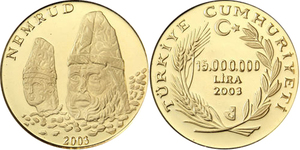Turkey - 2003 - 15,000,000 Turkish Lira - Mount Nemrut: Commagene
Identifier
ANRO-358
Reference Description
Obverse: Depicts the iconic colossal stone heads from Mount Nemrut, including representations of King Antiochus I of Commagene and deities from Greek, Armenian, and Persian traditions. The stone heads, surrounded by scattered rocks, capture the grandeur of this UNESCO World Heritage Site. The inscription "NEMRUD" is engraved at the top, with the year "2003" below.
Reverse: Features the national emblem of the Republic of Turkey, framed by olive and oak branches symbolizing peace and strength. The inscription "TÜRKİYE CUMHURİYETİ" (Republic of Turkey) encircles the top, with the denomination "15.000.000 LİRA" and the year "2003" inscribed in the center.
Reverse: Features the national emblem of the Republic of Turkey, framed by olive and oak branches symbolizing peace and strength. The inscription "TÜRKİYE CUMHURİYETİ" (Republic of Turkey) encircles the top, with the denomination "15.000.000 LİRA" and the year "2003" inscribed in the center.
Specifications
Country: Turkey
Subject: Nemrud
Date: 2003
Denomination: 15,000,000 lira
Metal: Gold
Weight: 1.24g
Diameter: 14mm
Edge: Reeded
Mintage: 1,820pcs.
Strike quality: Proof
Subject: Nemrud
Date: 2003
Denomination: 15,000,000 lira
Metal: Gold
Weight: 1.24g
Diameter: 14mm
Edge: Reeded
Mintage: 1,820pcs.
Strike quality: Proof
Notes
Mount Nemrut, located in southeastern Turkey, is one of the most significant archaeological sites of the ancient Kingdom of Commagene. Founded in the 1st century BCE by King Antiochus I, Commagene was a Hellenistic kingdom with strong Armenian and Persian influences. Antiochus I declared himself a descendant of both Persian King Darius I and Alexander the Great, blending cultural traditions from Armenia, Greece, and Persia in his kingdom.
The colossal stone heads on Mount Nemrut, part of a monumental tomb-sanctuary, represent deities such as Zeus, Apollo, and Hercules alongside Antiochus I. This unique blend of iconography reflects the multicultural identity of Commagene. Today, Mount Nemrut is a UNESCO World Heritage Site, symbolizing the rich cultural and historical heritage of the Armenian-influenced Kingdom of Commagene.
The colossal stone heads on Mount Nemrut, part of a monumental tomb-sanctuary, represent deities such as Zeus, Apollo, and Hercules alongside Antiochus I. This unique blend of iconography reflects the multicultural identity of Commagene. Today, Mount Nemrut is a UNESCO World Heritage Site, symbolizing the rich cultural and historical heritage of the Armenian-influenced Kingdom of Commagene.
See All Items in Category
Citation
“Turkey - 2003 - 15,000,000 Turkish Lira - Mount Nemrut: Commagene,” Armenian Numismatic Research Organization, accessed April 25, 2025, https://armnumres.org/items/show/358.


